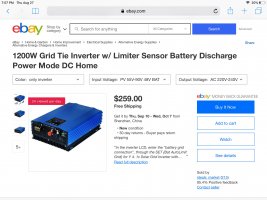Cheap4-life said:
The outback skybox operating battery voltage stopping at 60v is low for any inverter. Many inverters can operate with the battery voltage I have. Most inverters can use up to 66v some as high as 69v.
The problem is finding a grid tie inverter that operates using a lower voltage battery than most GTI string inverters would use. Most GTI inverters use a high voltage battery (over 120v) similar to their string array voltage, thats if they can use pv and battery power at the same time that the loads can use grid power. The GTIL2 is not a string inverter. It operates at a lower voltage because its not a string GTI. This allows it to use a low voltage (for a grid tie inverter) 45-90v battery.
If what I describe is normal then please mention 1 other GTI that is only a GTI (not high voltage string GTI) , and can also use pv then battery then also let loads use grid all the time.
Don't have an answer but just clarifying what you're looking for so maybe someone else can answer.
Most commercial rooftop grid-tie inverters like the sunnyboys, etc. are made for larger arrays. They also are spec'd for higher operating voltages, usually 250V-600V. But they also have a sweet spot that also coincide with the rating of the arrays. There's multiple advantages, lower gauge wiring, high efficiency, high output, etc. They also are made to output all energy to the grid. Their downside is when the grid power goes down, it also goes down. Thus the term grid-tied.
The GTIL2 is also a grid-tie inverter. It just so happens that it's made with the capability to limit output so in the case that you do not want to export excess energy (such as if you're not authorized to export or if you are not allowed to export power). These units are not high voltage because they are typically smaller units (1kw or 2kw at most), thus the arrays are small to begin with such low power. 3-4 panels are typical installs so the voltages are low even in series. That's why the operating voltage is only 45-90V. It just so happens that it falls in the realm of the voltages of batteries we use. Since it's DC it doesn't matter if the input power is coming from a solar panel or battery, DC current is DC current. But in the end it's just a grid-tie inverter with the ability to limit export current.
Now hybrid inverters are different. They are typically made as a off-grid and grid-tie inverter. So if the power was to go out, it will not be able to export to the grid. However, it is still capable to run a separate subpanel where all your critical loads would tend to be. These also come in higher power output such as 3kw or more. However, you are not interested in the off-grid part of it. The question is, can these hybrid inverters limit the export current during grid-tie? I know some have grid-zero features but that's just making sure it doesn't export energy from the subpanel. You're looking for something that can export energy but limit it to the entire house panel usage. This term is load shaving, and you are looking to charge the batteries with excess solar energy then load shave at night when you are using grid power. GTIL2 is more of a toy, and you're looking for a larger version of it.










